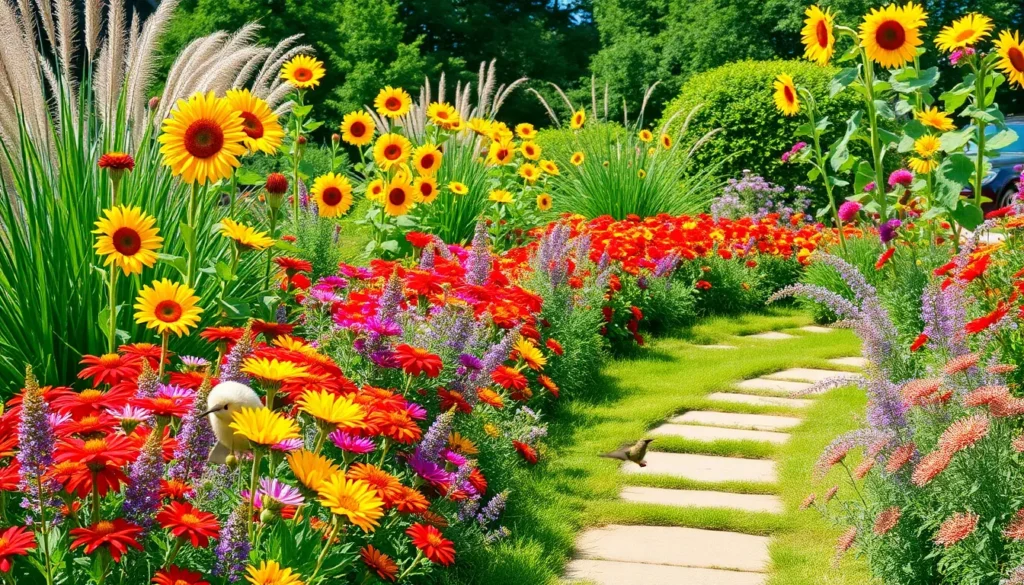Creating stunning garden borders transforms your outdoor space from ordinary to extraordinary. We’ve discovered that the right combination of plants can define pathways frame flower beds and add structure to any industry design. Whether you’re working with a small urban garden or sprawling countryside property the perfect border plants make all the difference.
We understand that choosing the ideal plants for your garden borders can feel overwhelming with countless varieties textures and heights to consider. From low-growing perennials that create neat edges to dramatic ornamental grasses that add movement and privacy each plant serves a unique purpose in your overall design.
The secret lies in selecting plants that complement your existing industry while providing year-round interest. We’ll guide you through proven border plant combinations that deliver stunning visual impact require minimal maintenance and thrive in various growing conditions. Your dream garden border is closer than you think.
Create Stunning Perennial Borders With Long-Blooming Flowers
Building upon the foundation of plant selection principles, we’ll now explore how strategic perennial choices can transform your garden borders into vibrant, ever-changing displays.
Choose Reliable Perennials for Continuous Color
Black-eyed Susans deliver bright yellow blooms from June through October, making them cornerstone plants for extended color displays. These hardy perennials thrive in full sun and tolerate drought conditions once established. Coneflowers complement Black-eyed Susans perfectly with their purple, pink, or white petals that attract butterflies throughout summer and fall.
Catmint provides soft lavender spikes that bloom repeatedly when cut back, creating waves of color from spring through frost. We recommend the ‘Walker’s Low’ variety for its compact growth habit and exceptional flowering performance. Salvia varieties like ‘May Night’ offer deep purple flower spikes that contrast beautifully with lighter colored perennials.
Daylilies ensure continuous blooms with different varieties flowering at various times throughout the growing season. Choose early, mid, and late season cultivars to extend the blooming period from June through September.
| Perennial | Bloom Period | Height | Color Options |
|---|---|---|---|
| Black-eyed Susan | June-October | 24-36 inches | Yellow, orange |
| Coneflower | July-September | 18-48 inches | Purple, pink, white |
| Catmint | May-October | 12-24 inches | Lavender, blue |
| Salvia | May-September | 18-24 inches | Purple, blue, red |
| Daylily | June-September | 12-48 inches | Multiple colors |
Plant Height-Varied Combinations for Visual Interest
Tall backdrop plants like Joe Pye Weed and Garden Phlox create dramatic vertical elements reaching 4-6 feet in height. These substantial perennials anchor border designs while providing late summer color when many other plants fade.
Medium height perennials such as Bee Balm and Russian Sage fill the middle layer at 2-3 feet tall. Bee Balm offers vibrant red blooms that hummingbirds love, while Russian Sage contributes silvery foliage and delicate purple flowers.
Low growing edging plants like Coral Bells and Lamb’s Ear define border edges with their compact 6-12 inch heights. Coral Bells provide colorful foliage in shades of burgundy, lime, or bronze, while Lamb’s Ear adds soft silver texture.
Groundcover perennials including Wild Ginger and Ajuga weave between taller plants to suppress weeds and create visual cohesion. These spreading plants typically stay under 8 inches tall while covering substantial ground area.
Select Season-Extending Varieties for Year-Round Appeal
Spring emergence perennials like Hellebores and Pulmonaria begin the garden season with early blooms before most other plants awaken. Hellebores offer rose-like flowers in white, pink, or burgundy from February through April, while Pulmonaria displays spotted leaves and blue or pink flowers.
Summer stalwarts including Rudbeckia and Echinacea maintain peak performance during hot weather when many plants struggle. These drought tolerant perennials continue blooming through heat waves and dry spells.
Fall flowering champions such as Asters and Sedum provide crucial late season color when most gardens begin declining. New England Asters burst with purple or white daisy-like flowers, while Sedum varieties offer succulent foliage topped with pink or red flower clusters.
Winter interest plants like Ornamental Grasses and seed-producing perennials extend garden appeal beyond the growing season. Feather Reed Grass maintains upright structure through winter storms, while Coneflower seed heads attract birds and add textural interest to snow-covered borders.
Design Colorful Annual Borders for Seasonal Impact
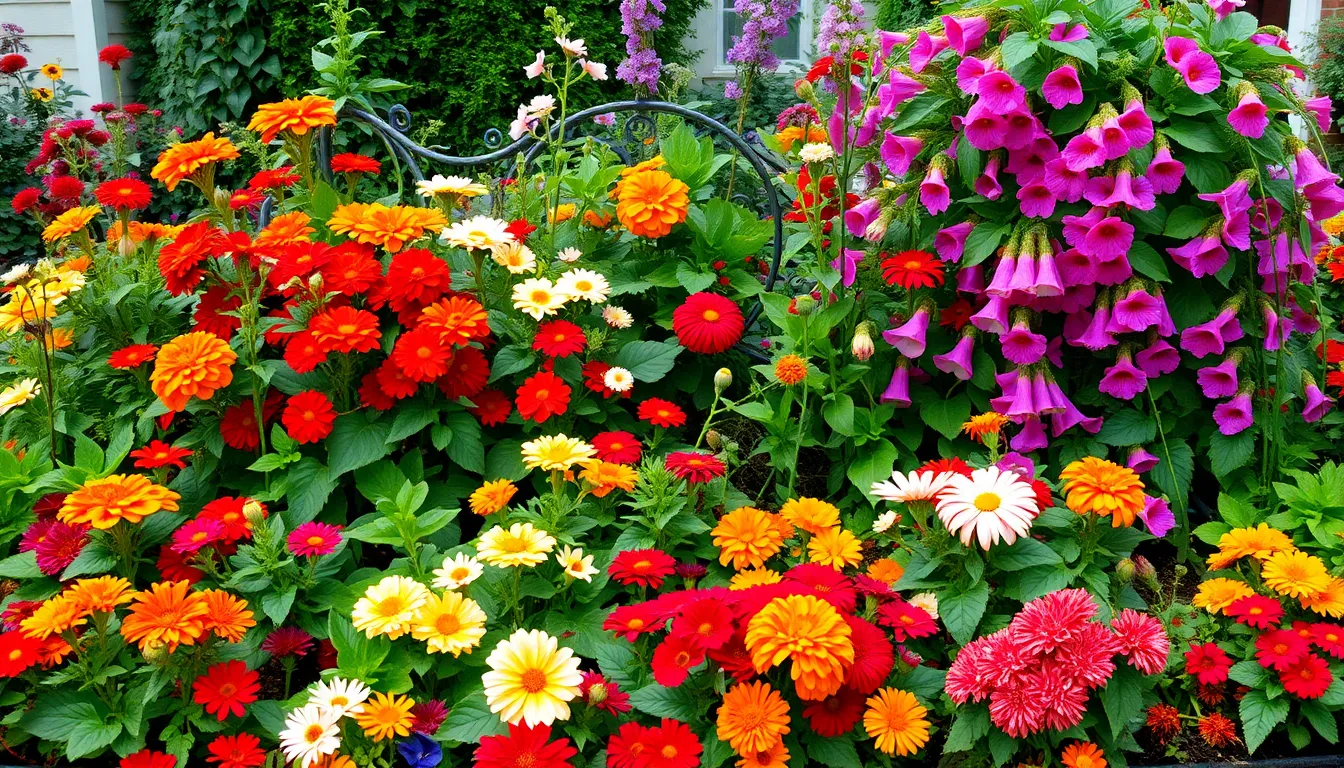
Annual plants deliver vibrant, season-long color that transforms garden borders into stunning seasonal displays. We can change these displays yearly for fresh looks while maintaining the structural foundation our perennials provide.
Pick Fast-Growing Annuals for Quick Results
Petunias and marigolds lead our list of fast-growing annuals that provide immediate border impact. These champions fill gaps swiftly and create full displays within weeks of planting.
Climbing annuals on supports like wigwams add vertical drama and height quickly to our borders. Morning glories, sweet peas, and nasturtiums scramble up structures to create living walls of color.
French marigolds deserve special mention for their rapid establishment and continuous blooming. We position these compact powerhouses at border fronts where their quick growth creates instant definition.
Zinnia varieties germinate rapidly and produce cut-worthy blooms throughout the season. State Fair Mix and Profusion series varieties give us reliable color within 60 days of sowing.
Mix Complementary Colors for Bold Statements
Complementary color combinations create striking visual contrasts that make our borders pop. Purple and yellow pairings using petunias with marigolds deliver maximum impact.
Coleus foliage provides dramatic texture and color contrast as vibrant backdrops for blooming annuals. Wizard Mix and ColorBlaze series offer burgundy, lime green, and variegated options that intensify our color schemes.
Red and green combinations using scarlet sage with decorative kale create sophisticated autumn displays. These contrasting hues draw the eye while maintaining elegant balance.
Orange and blue pairings featuring calendulas with lobelia produce energetic borders that buzz with activity. We scatter these combinations throughout our plantings for consistent visual rhythm.
Plan Succession Planting for Extended Blooms
Early spring plantings begin our succession strategy with cold-tolerant annuals like pansies and snapdragons. These performers bridge the gap between winter and our main seasonal display.
Mid-season introductions feature heat-loving varieties like celosia and vinca that peak during summer months. We integrate these gradually as spring bloomers fade.
Late summer additions include chrysanthemums and ornamental peppers that carry color into fall. These replacements maintain border interest as earlier plantings decline.
Progressive replacement schedules keep our borders fresh by rotating spent plants with new varieties every 6-8 weeks. This strategy ensures continuous color from spring through first frost.
Establish Low-Maintenance Shrub Borders for Structure
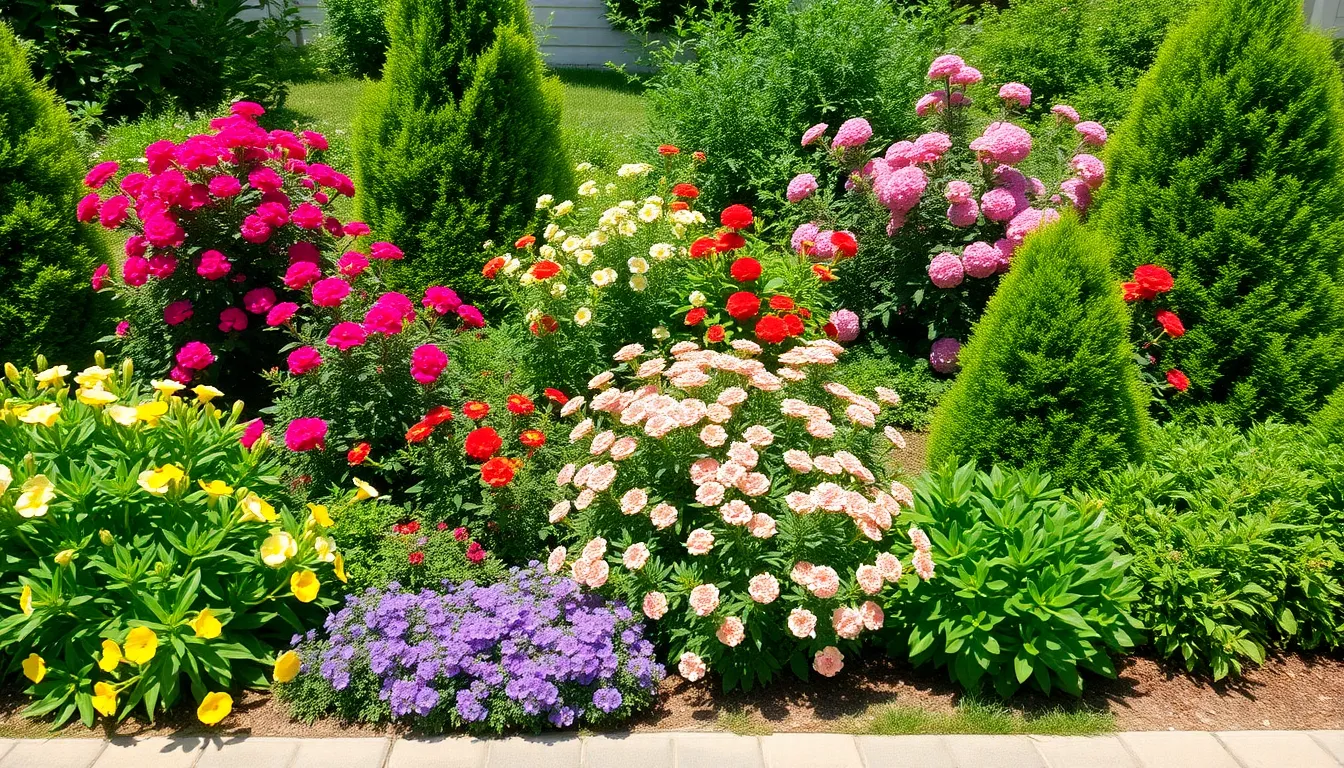
Building on our foundation of perennials and annuals, we can create lasting garden structure with shrubs that require minimal upkeep. Strategic placement of low-maintenance shrubs like hebes, osmanthus, sarcococca, and viburnums forms the backbone of successful borders while reducing our gardening workload.
Select Native Shrubs for Easy Care
Native shrubs naturally thrive in local conditions without constant attention from us. Potentillas deliver attractive flowers throughout an extended season while remaining exceptionally durable and low-maintenance according to Proven Winners research. These hardy performers adapt to our exact climate and soil conditions, eliminating the need for frequent watering or special care routines.
Choosing Amelanchier lamarckii provides us with multi-season interest through spring flowers, wildlife-friendly fruits, and striking autumn foliage. Local native species consistently outperform exotic alternatives because they’ve evolved alongside our regional weather patterns and soil types. We’ll find these plants resist pests and diseases more effectively than non-native alternatives.
Incorporate Evergreen Options for Winter Interest
Evergreen shrubs maintain visual appeal when deciduous plants become dormant during winter months. Boxwood and dwarf evergreen varieties create tidy, structured borders that look polished year-round. These reliable performers ensure our garden borders never appear bare or forgotten.
Winter-flowering evergreens like viburnums, osmanthus, and sarcococca add both greenery and delightful fragrance during colder seasons. We can count on these shrubs to provide consistent structure while most other plants rest. Their presence transforms what could be a barren winter industry into an inviting garden space.
Add Flowering Shrubs for Seasonal Highlights
Flowering shrubs inject seasonal color and texture into our border designs throughout the growing season. Potentillas bloom continuously from spring through fall, providing us with months of colorful displays. We can enhance these foundation plantings with complementary perennials and low-maintenance annuals like dwarf zinnias and calibrachoas for added brightness.
Combining these flowering shrubs with simple repetition creates higher visual impact while keeping maintenance requirements minimal. Early spring bloomers like Amelanchier offer flowers followed by colorful fruit and autumn foliage, giving us three seasons of interest from a single plant. Ground cover additions such as sedums, delosperma, and sweet woodruff at border edges help suppress weeds while adding textural variety to our designs.
Build Mixed Borders Combining Multiple Plant Types
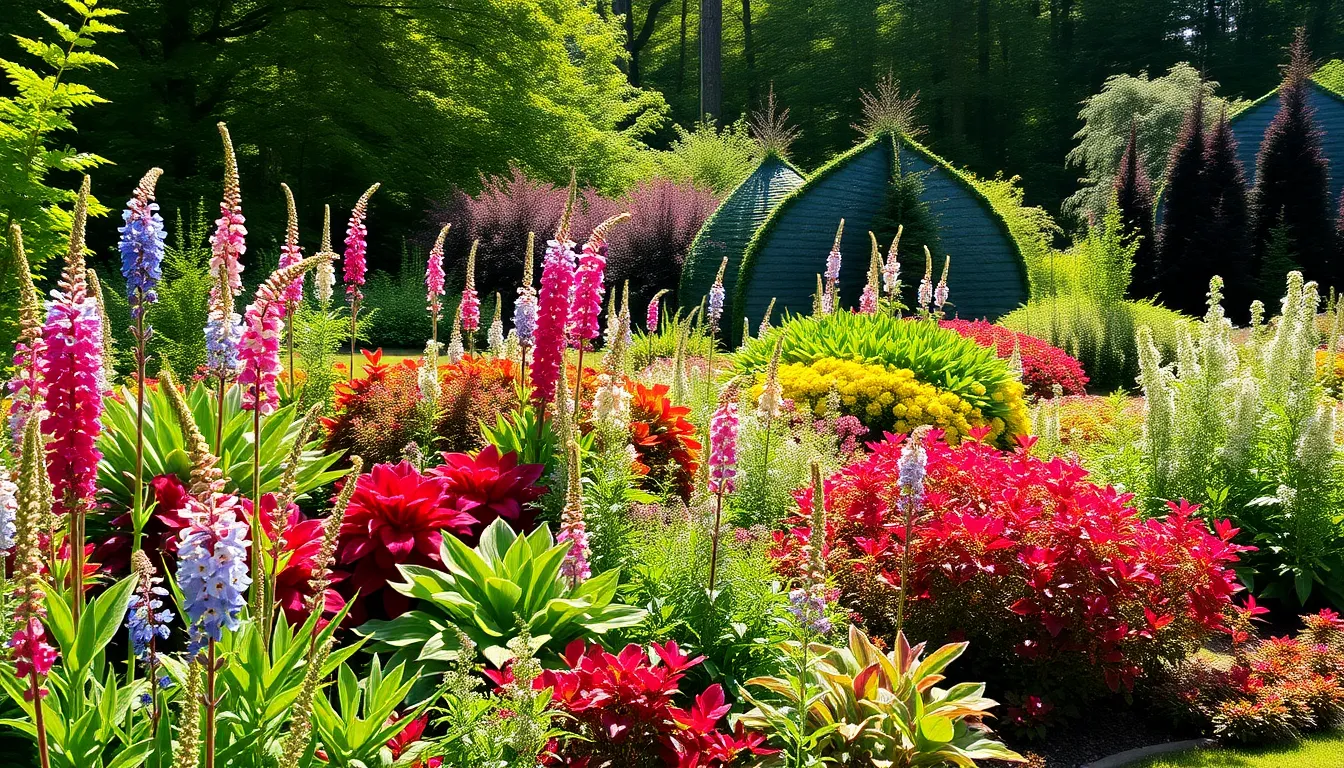
Mixed borders offer the ultimate flexibility for creating ever-changing garden displays that provide year-round interest. We can combine annuals, perennials, shrubs, and sometimes trees along boundaries like walls, walkways, or fences to achieve layered seasons and varied plant forms.
Layer Plants by Height and Texture
Effective borders require strategic placement of plants according to their mature height to create visual depth and structure. We position taller species like delphiniums or fennel at the back of borders to provide backbone structure and screen fences or walls, while medium-height plants fill the middle ground and groundcover varieties anchor the front edges.
Texture contrast adds remarkable visual interest and prevents monotonous displays. We pair feathery foliage plants with broad-leaved specimens to create captivating combinations that draw the eye throughout the border. Fine-textured ornamental grasses complement bold hostas beautifully, while delicate ferns provide soft contrast against architectural plant forms like yuccas or agaves.
Height layering works differently for island beds where we place tall plants centrally and arrange shorter varieties radiating outward. This approach creates 360-degree viewing angles and allows us to appreciate the border from multiple perspectives throughout the garden.
Balance Foliage and Flowering Elements
Balancing green foliage with blooming flowers creates appealing and ever-changing borders that maintain interest even when flowers aren’t in peak bloom. We incorporate plants with vibrant or variegated leaves, such as coral bells with colorful foliage, to highlight and complement nearby flowering specimens.
Plants that provide both foliage interest and seasonal flowers maximize our design impact across multiple seasons. Heucheras offer stunning leaf colors in burgundy, lime, or silver while producing delicate flower spikes, giving us double value from single plants.
Foliage plants serve as crucial supporting actors that enhance flowering stars without competing for attention. We use plants with interesting leaf shapes, colors, or textures as living backdrops that make bright blooms appear more vibrant and create cohesive color schemes throughout the growing season.
Create Transitions Between Garden Zones
Borders serve as natural bridges between different garden areas by using plant groupings that gradually change in height, color, or form. We create smooth transitions by carefully selecting and layering shrubs and perennials that blend one garden zone seamlessly into the next.
Plant placement and layering techniques help maintain harmony and flow throughout our overall garden design. We might use medium-height ornamental grasses to transition from a formal perennial border into a naturalistic woodland area, or employ gradually changing flower colors to connect vibrant annual displays with subdued foliage gardens.
Repetition of key plants or color themes throughout transitional areas creates visual continuity that unifies separate garden spaces. We strategically repeat anchor plants like boxwood or lavender at regular intervals to provide consistent reference points that guide visitors naturally from one garden zone to another.
Plant Cottage Garden Borders for Informal Charm
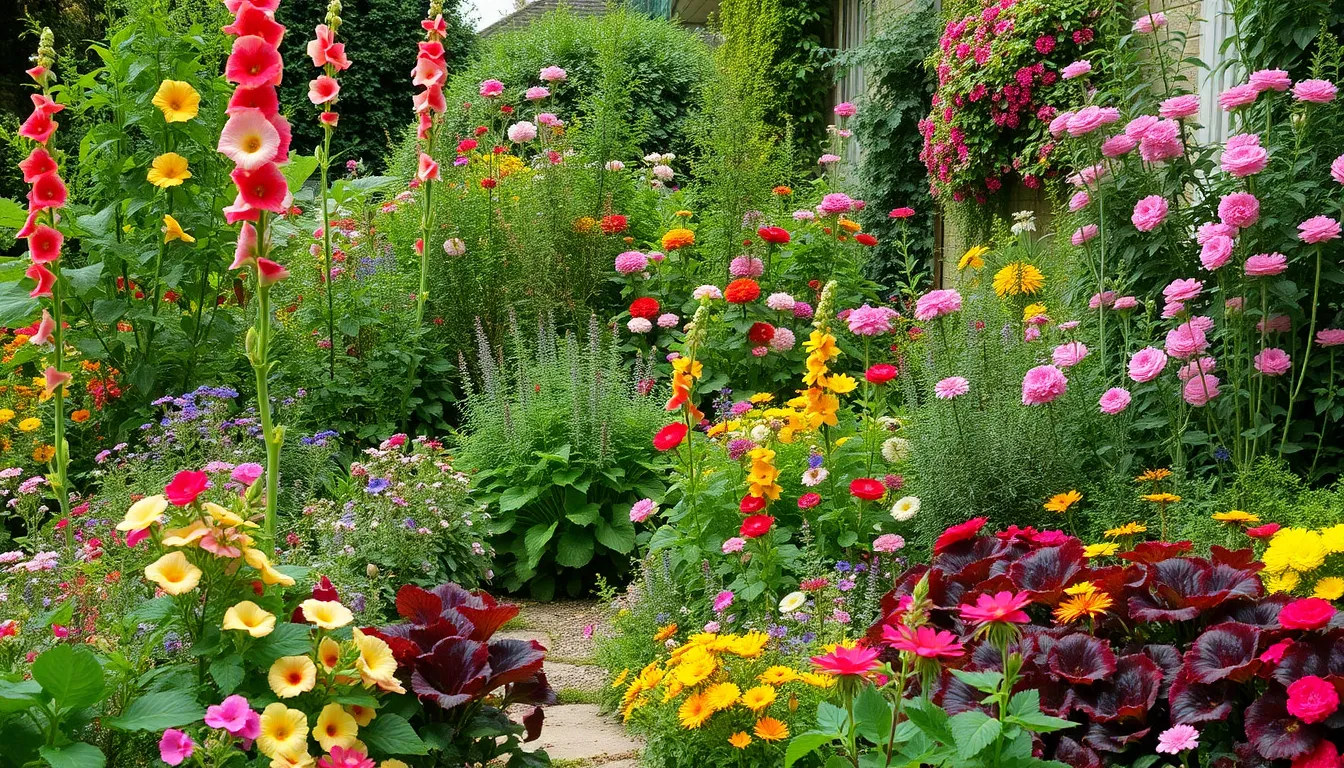
Unlike the structured precision of mixed borders, cottage garden borders embrace a delightfully informal approach that celebrates natural beauty and spontaneous growth. We’re creating relaxed, naturalistic displays that combine plants in a charming jumble of colors and textures.
Choose Heritage Varieties for Authentic Appeal
Heritage varieties form the backbone of authentic cottage garden borders, bringing timeless charm that perfectly complements the informal style we’re cultivating. Hollyhocks stand as classic tall plants at 6-8 feet, widely appreciated for their roadside wild beauty and nostalgic cottage garden appeal. We recommend planting Campanula lactiflora varieties like ‘Loddon Anna’ to provide height at the back of borders while maintaining that authentic heritage feel.
Hardy geraniums work beautifully as mid-border plants, offering continuous blooms and the historical charm cottage gardens demand. Rock roses (Helianthemum) excel as low-growing front border plants, creating soft, lush edges that feel both timeless and natural. These heritage selections tend to be hardy, long-flowering, and bee-friendly, reinforcing our garden’s ecological health while maintaining that coveted historical authenticity.
Traditional varieties often require less maintenance than modern hybrids, making them perfect for the low-intervention approach cottage gardens celebrate. We’re selecting plants that our gardening ancestors would recognize, creating connections to gardening heritage while building sustainable, beautiful borders.
Allow Natural Self-Seeding for Organic Growth
Natural self-seeding creates the organic, evolving character that defines successful cottage garden borders, transforming static plantings into ever-changing, ever-changing displays. We’re encouraging plants to spread and fill in naturally over time, eliminating the need for overly formal planting schemes that feel staged or artificial.
Self-seeding plants create sustainable, low-maintenance gardens that enhance diversity and fullness without constant replanting efforts. Allowing natural propagation means our borders become more abundant each year, with plants establishing themselves in perfect microclimates they choose. We observe which plants thrive in exact spots, letting nature guide our garden’s development rather than fighting against natural tendencies.
This approach creates delightful surprises as plants appear in unexpected locations, often creating better combinations than we could plan. Cottage garden borders evolve organically, developing unique personalities that reflect both our site conditions and the plants’ natural preferences. We’re fostering gardens that feel alive and spontaneous, capturing the essence of traditional cottage garden charm.
Mix Vegetables and Flowers for Practical Beauty
Combining vegetables with flowers reflects cottage gardens’ origins as practical homestead gardens, blending beauty with function in ways that maximize both aesthetic appeal and garden productivity. We’re incorporating herbs, vegetables, and flowers together, creating borders that provide edible crops alongside colorful blooms throughout the growing season.
This traditional approach increases biodiversity while attracting beneficial insects that support both ornamental and edible plants. Mixed plantings make efficient use of garden space, allowing us to grow food without sacrificing beauty or creating separate utility areas that feel disconnected from our ornamental borders.
Practical beauty emerges when we plant lettuces alongside sweet alyssum, or incorporate climbing beans with morning glories for vertical interest. We’re selecting vegetables with ornamental value, such as colorful chard, purple kale, or flowering herbs like lavender and rosemary that contribute structure and fragrance. This integration creates borders that serve multiple purposes while maintaining the informal, abundant character cottage gardens celebrate.
Install Modern Minimalist Borders for Clean Lines
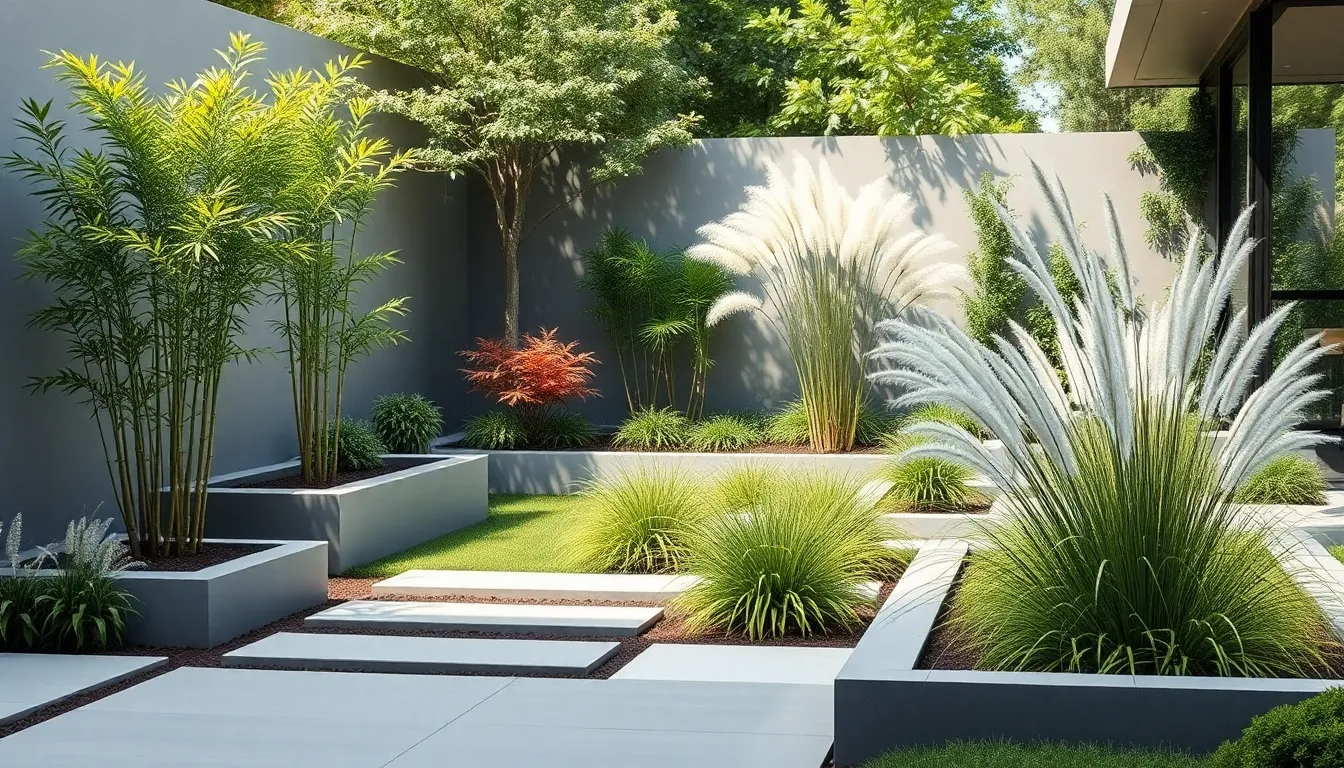
Modern minimalist garden borders shift away from the informal charm we’ve explored toward sleek, contemporary designs that emphasize geometric precision. We achieve this sophisticated aesthetic through careful material selection and strategic plant placement that creates visual calm.
Use Architectural Plants for Strong Forms
Architectural plants transform minimalist borders into striking focal points through their bold, sculptural shapes. We recommend selecting plants like bamboo, Japanese maple, and agave that serve as living sculptures within our garden framework. These specimens create dramatic vertical elements and structural definition that reinforces the clean lines of modern design.
Bamboo varieties offer excellent screening properties while maintaining their architectural integrity throughout seasons. Japanese maples provide stunning seasonal color changes without compromising their distinctive branching patterns. Agave plants deliver year-round sculptural interest with their geometric rosette forms that complement contemporary hardscaping materials.
Strategic placement of these architectural specimens creates powerful visual anchors along border edges. We position them at regular intervals to establish rhythm and repetition that enhances the minimalist aesthetic. Their strong forms contrast beautifully with softer companion plantings while maintaining the sophisticated appeal we’re seeking.
Limit Color Palettes for Sophisticated Appeal
Limited color palettes elevate garden borders from chaotic displays to harmonious compositions that exude sophistication. We achieve this refined look by restricting our plant selections to monochromatic schemes or subtle color variations that allow texture and form to dominate the visual experience.
Neutral tones like whites, soft greens, and pale pastels create cohesive borders that complement contemporary architecture and hardscaping elements. This restrained approach lets us focus on the interplay between different plant textures rather than competing colors. Silver foliage plants paired with white flowering specimens create elegant combinations that remain visually interesting without overwhelming the senses.
Repeating color themes throughout the border length strengthens visual continuity and reinforces our minimalist goals. We select plants that bloom in similar shades at different times to maintain color consistency across seasons. This strategic repetition creates sophisticated borders that feel intentional and professionally designed.
Incorporate Ornamental Grasses for Movement
Ornamental grasses introduce ever-changing movement to our minimalist borders while preserving their clean aesthetic through subtle textural interest. We use varieties like miscanthus, fountain grass, and blue fescue to create gentle motion that contrasts with the static forms of architectural plants.
These graceful specimens sway naturally with wind currents, adding life and rhythm to otherwise structured plantings. Their fine blade textures soften harsh edges of hardscaping materials like concrete or stone while maintaining the understated elegance essential to minimalist design. Blue fescue provides compact options for smaller spaces, while miscanthus delivers impressive height for dramatic backdrop effects.
Seasonal changes in ornamental grasses extend visual interest throughout the year without requiring intensive maintenance. We appreciate how their seedheads catch light and provide winter structure when other plants have gone dormant. This natural progression aligns perfectly with minimalist principles that celebrate simplicity and seasonal beauty.
Develop Shade Border Gardens for Difficult Areas
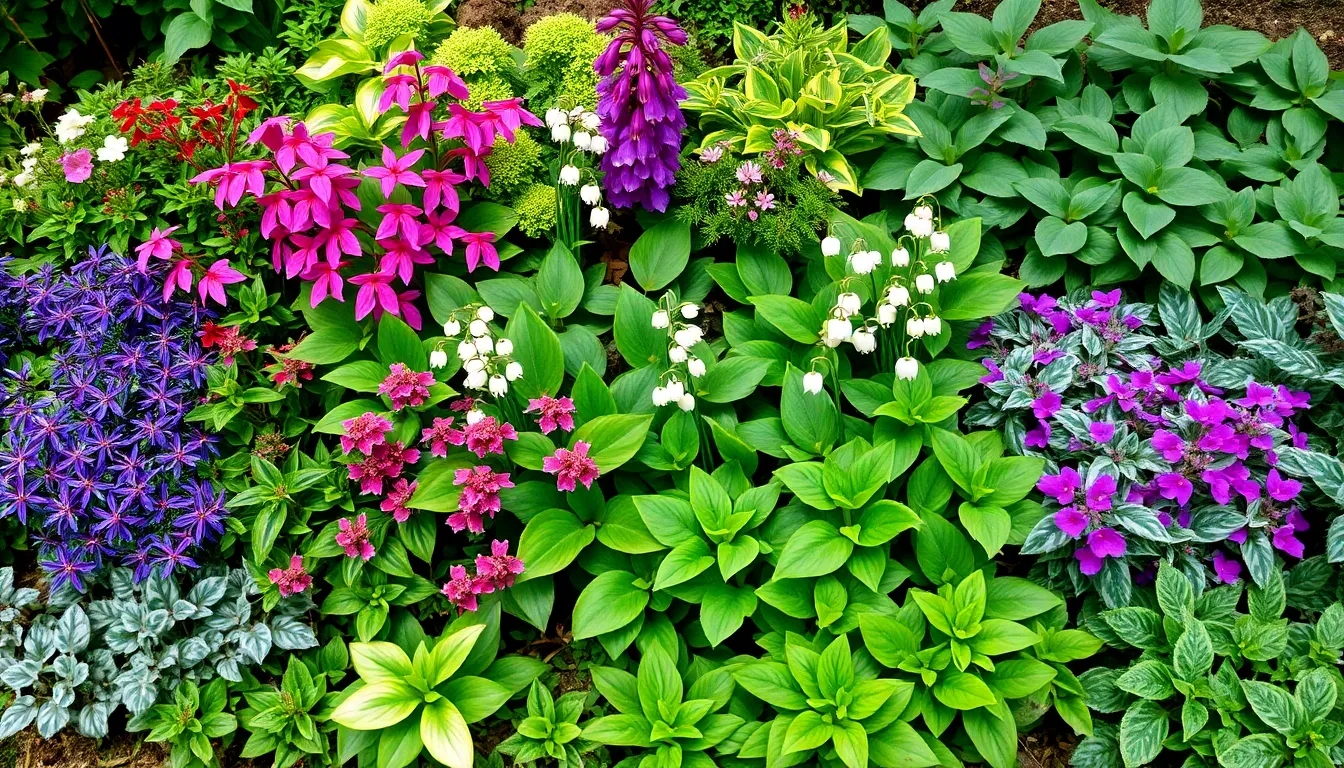
Transforming challenging low-light spaces into vibrant garden features becomes achievable when we focus on shade border gardens. Success comes from creating layered planting schemes that mimic natural woodland environments by combining trees, shrubs, perennials, bulbs, and annuals together.
Select Shade-Tolerant Flowering Plants
Finding flowering plants that thrive in shade allows us to bring color even to less sunny garden spots. Pulmonaria (lungwort) and Geranium phaeum varieties deliver spots of early color when most other plants remain dormant. Lily of the Valley spreads naturally to form wide clumps while producing scented spring blooms that perfume shaded areas.
Evergreen groundcovers like Vinca minor serve dual purposes by adding both continuous greenery and delicate flowers throughout the growing season. While shade conditions limit the range of highly colorful flowers compared to sunny borders, many plants still bloom reliably when we select varieties specifically listed as shade tolerant by horticultural authorities.
Add Foliage Plants for Texture and Interest
Leaf texture and contrast become crucial elements in shade border appeal since flowers appear less abundantly than in sunny locations. Combining long, thin leaves with rounded or heart-shaped varieties creates visual dynamics that capture attention. Mixing spikes with spheres and soft foliage with striking architectural shapes adds layers of interest that work year-round.
Using many shades of green alongside variegated leaves creates bright focal points throughout shaded borders. This foliage-focused approach maintains appeal through winter months when many summer flowering borders go completely bare, ensuring our shade gardens remain attractive in all seasons.
Create Bright Spots With Variegated Varieties
Variegated plants with multi-colored leaves brighten shady borders more effectively than relying solely on flowers. Placing these eye-catching specimens among predominantly green plants lifts the overall visual appeal while defining distinct spaces within our garden design.
Strategic positioning of variegated varieties creates natural focal points that draw the eye through shaded areas, making difficult garden spots feel intentional and beautifully designed rather than neglected afterthoughts.
Establish Drought-Tolerant Borders for Water-Wise Gardening
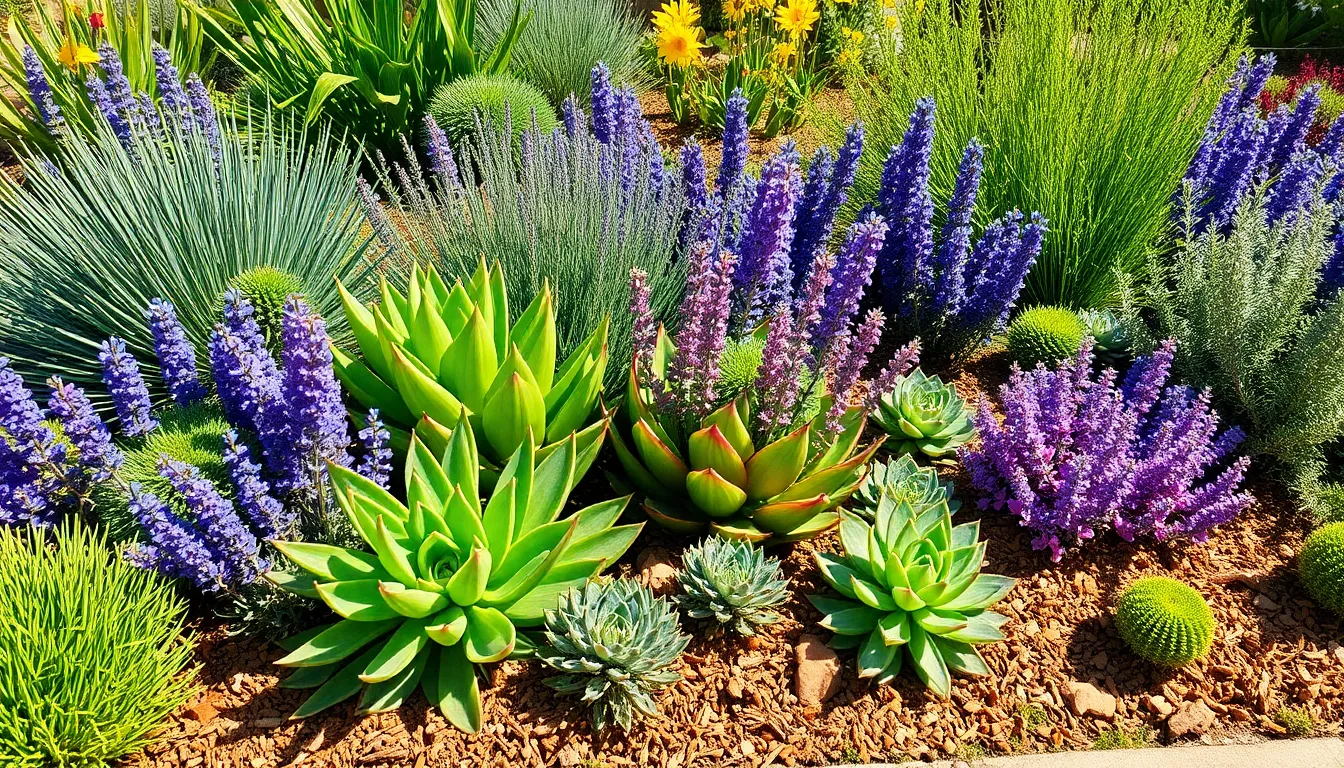
Water conservation becomes increasingly important as we design sustainable garden borders that thrive with minimal irrigation. Selecting plants with low water needs reduces maintenance while creating beautiful, resilient borders that support both environmental goals and stunning garden displays.
Choose Succulent and Mediterranean Plants
Succulents store water in their fleshy tissues, making them perfect candidates for drought-tolerant borders that require minimal watering. Mediterranean plants like lavender, salvia, and rosemary have adapted to hot, dry climates and flourish in full sun conditions with well-drained soil. These hardy species provide continuous color and fragrance while demanding very little water once established.
Combining different succulent varieties creates textural interest through their diverse forms, from spiky agaves to rounded sedums. Mediterranean herbs offer dual benefits as they provide culinary value alongside their ornamental appeal in border designs. Both plant categories develop extensive root systems that efficiently capture available moisture from the soil.
Group Plants by Water Requirements
Efficient irrigation begins with organizing plants according to their exact water needs throughout your border design. Placing drought-tolerant species together prevents overwatering sensitive plants while ensuring each variety receives appropriate moisture levels. This strategic grouping eliminates water waste and creates healthier growing conditions for all border plants.
Separating water-intensive plants from dry-loving species allows us to customize irrigation zones within the same garden space. Mediterranean plants thrive when grouped with other sun-loving, drought-resistant varieties rather than mixed with moisture-dependent perennials. This approach creates distinct microclimates that support each plant’s natural growing requirements.
Add Mulch and Ground Covers for Moisture Retention
Mulching around drought-tolerant plants reduces soil evaporation by up to 70% while moderating temperature fluctuations that stress plant roots. Organic mulches like wood chips or gravel create protective barriers that conserve existing soil moisture during hot summer months. Ground covers provide living mulch that shades soil surfaces and suppresses water-competing weeds.
Strategic mulch application maintains consistent soil moisture levels between watering sessions, extending the time between irrigation needs. Ground covers like creeping thyme or sedum varieties spread naturally to fill spaces while requiring minimal water input. Both mulching and ground cover strategies work together to create self-sustaining border ecosystems that conserve water resources.
Design Seasonal Borders for Year-Round Interest
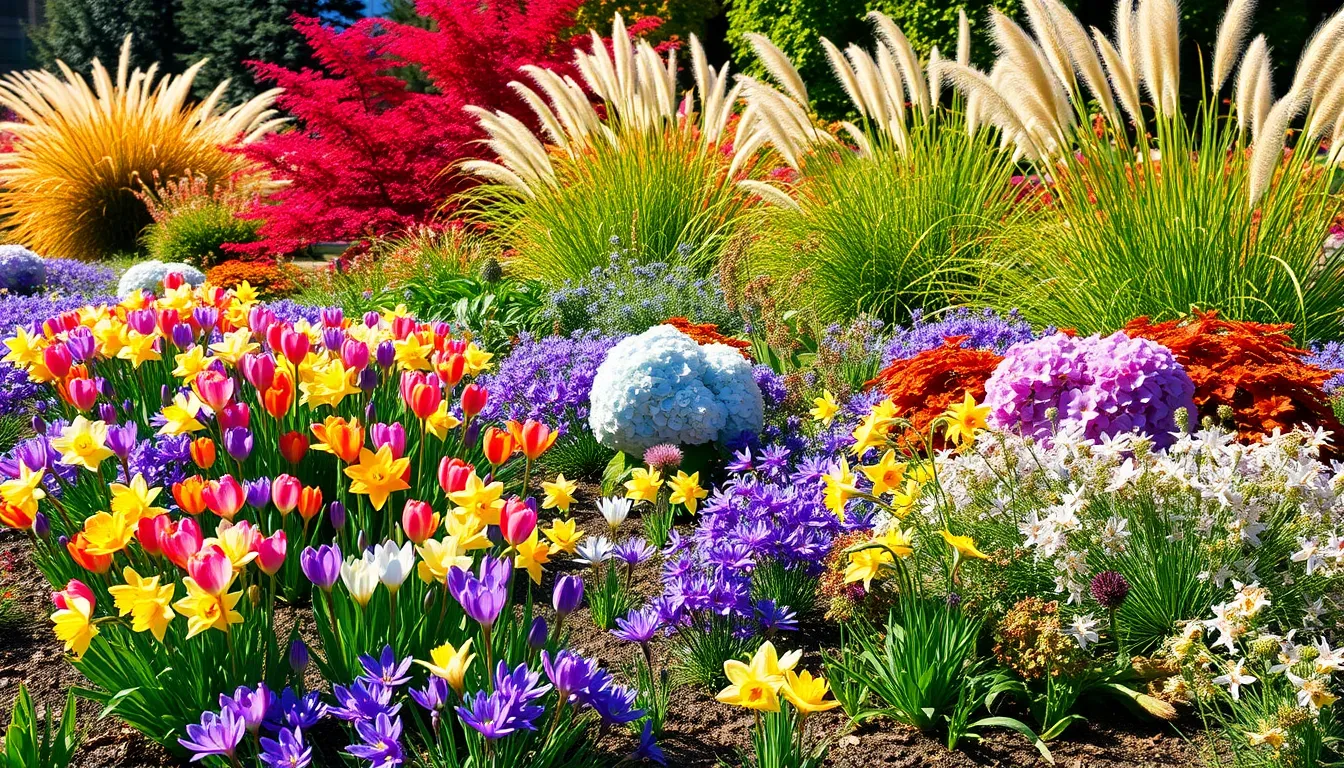
Creating borders that captivate throughout every season requires strategic layering and thoughtful plant selection. We’ll build upon our drought tolerant foundation by incorporating seasonal elements that ensure continuous visual appeal.
Plan Spring Bulb Displays for Early Color
Spring bulbs like tulips, daffodils, and crocuses deliver the year’s first vibrant awakening after winter’s dormancy. We plant these bulbs in fall, allowing them to establish root systems before cold weather arrives. Daffodils naturalize beautifully in border settings, multiplying year after year to create impressive drifts of yellow and white blooms.
Tulips offer the widest color range, from deep purples to bright oranges, letting us coordinate with our existing perennial color schemes. Crocuses emerge earliest, often pushing through snow to signal spring’s arrival with delicate purple, white, and yellow flowers. We position these bulbs strategically among our perennial plantings, where their foliage can die back naturally while being concealed by emerging summer growth.
Early flowering bulbs complement evergreen structural plants perfectly, creating bright focal points against dark winter backdrops. We interplant different bulb varieties to extend the spring display from February through May, ensuring continuous color during this transitional season.
Include Summer Blooming Champions
Summer brings our borders to full glory with robust perennials and flowering shrubs that thrive in warm weather. Hydrangeas anchor summer borders with massive flower heads in blues, pinks, and whites, providing months of continuous blooms from June through September. Agapanthus creates dramatic vertical accents with spherical clusters of blue or white flowers atop tall stems.
Iris varieties offer early summer elegance with sword like foliage and intricate blooms in virtually every color imaginable. We select bearded iris for their reliability and repeat blooming varieties for extended flowering periods. Day lilies complement iris perfectly, with strap like leaves and trumpet shaped flowers that open fresh each morning.
These summer champions create the backbone of our seasonal display, providing lush textures and abundant blooms during the garden’s peak growing period. We position taller varieties like hydrangeas toward the back of borders, with medium height plants like agapanthus in the middle, and lower growing perennials at the front edge.
Add Fall Foliage and Winter Structure Plants
Fall transforms our borders with spectacular foliage colors and architectural seed heads that carry interest into winter months. Ornamental grasses like fountain grass and feather reed grass develop golden plumes that catch autumn light and provide movement in winter breezes. We leave these grasses standing through winter for their sculptural silhouettes against snow.
Japanese maples contribute brilliant red and orange autumn foliage, creating stunning focal points that complement our drought tolerant plantings. Burning bush shrubs deliver intense scarlet fall color, while native sumac provides fiery orange and red leaves that persist well into November.
Winter structure comes from plants with strong architectural forms and interesting textures. Clipped evergreen hedges create “structural ribbons” that add rhythm and framework to perennial dominated borders throughout the year. Seed heads from plants like echinacea and rudbeckia provide winter food for birds while adding textural interest to frost covered borders.
We incorporate these elements strategically, ensuring that each season builds upon the last to create borders that remain captivating and beautiful regardless of weather or time of year.
Conclusion
Creating stunning garden borders becomes achievable when we understand the diverse options available to us. From the structured elegance of perennial displays to the relaxed charm of cottage gardens we’ve explored comprehensive approaches that suit every gardening style and maintenance preference.
The key lies in matching our plant choices to both our aesthetic vision and practical needs. Whether we’re designing drought-tolerant borders for water conservation or embracing mixed plantings for year-round interest the principles remain consistent: thoughtful planning strategic layering and understanding our local growing conditions.
With these ideas and techniques we can transform any outdoor space into a beautifully bordered garden that reflects our personal style while providing lasting enjoyment throughout the seasons.
Frequently Asked Questions
What are the key benefits of creating garden borders?
Garden borders enhance outdoor spaces by defining pathways, framing flower beds, and adding structure to garden designs. They provide visual interest, help organize different garden zones, and can be tailored to complement existing landscape features. Well-designed borders create focal points and improve the overall aesthetic appeal of both small urban gardens and large countryside properties.
Which perennials are best for continuous color in borders?
Black-eyed Susans and Coneflowers are excellent choices for reliable, continuous color throughout the growing season. Catmint and Salvia add visual interest with their unique textures and prolonged blooming periods. These perennials are low-maintenance and provide consistent performance year after year, making them ideal foundation plants for border designs.
How should I layer plants by height in my border design?
Create layered designs by placing tall backdrop plants like Joe Pye Weed at the back, medium-height perennials such as Bee Balm in the middle, and low-growing edging plants like Coral Bells at the front. This three-tier approach creates visual depth and ensures all plants receive adequate light while maintaining proper proportions.
What annuals work best for quick, colorful border displays?
Fast-growing annuals like petunias and marigolds provide quick results and vibrant, season-long color. For vertical drama, consider climbing annuals such as morning glories and sweet peas. These plants allow for yearly changes in your display while maintaining the structural foundation provided by perennials, offering flexibility in design.
Which shrubs require minimal maintenance for border plantings?
Native shrubs like potentillas and Amelanchier lamarckii thrive in local conditions and require less care than non-native varieties. Evergreen options such as boxwood maintain visual appeal during winter months, while flowering shrubs provide seasonal highlights. These selections offer lasting structure with minimal upkeep requirements.
How do I create a successful mixed border design?
Combine annuals, perennials, shrubs, and sometimes trees to create flexible, layered displays. Layer plants by height and texture, balance foliage and flowering elements, and create smooth transitions between different garden zones. Use repetition of key plants or color themes to enhance visual continuity throughout the garden.
What defines a cottage garden border style?
Cottage garden borders embrace an informal approach celebrating natural beauty and spontaneous growth. Use heritage varieties like hollyhocks and hardy geraniums, allow natural self-seeding for organic evolution, and mix vegetables with flowers. This style reflects the practical origins of cottage gardens as productive homesteads.
How can I achieve a modern minimalist border design?
Focus on geometric precision through careful material selection and strategic plant placement. Use architectural plants like bamboo, Japanese maple, and agave as focal points. Limit color palettes to neutral tones and incorporate ornamental grasses for movement and texture while maintaining a clean, sophisticated aesthetic.
What plants work best for drought-tolerant borders?
Succulents and Mediterranean plants like lavender and rosemary are excellent choices for their resilience and minimal irrigation requirements. Group plants by water needs to optimize irrigation, use mulching for moisture retention, and select ground covers that conserve water. These create self-sustaining border ecosystems.
How do I plan borders for year-round seasonal interest?
Plan spring bulb displays with tulips, daffodils, and crocuses interplanted with perennials. Use robust summer perennials and flowering shrubs like hydrangeas and irises. Incorporate fall plants with spectacular foliage and architectural seed heads, plus evergreen plants and ornamental grasses for winter structure.

